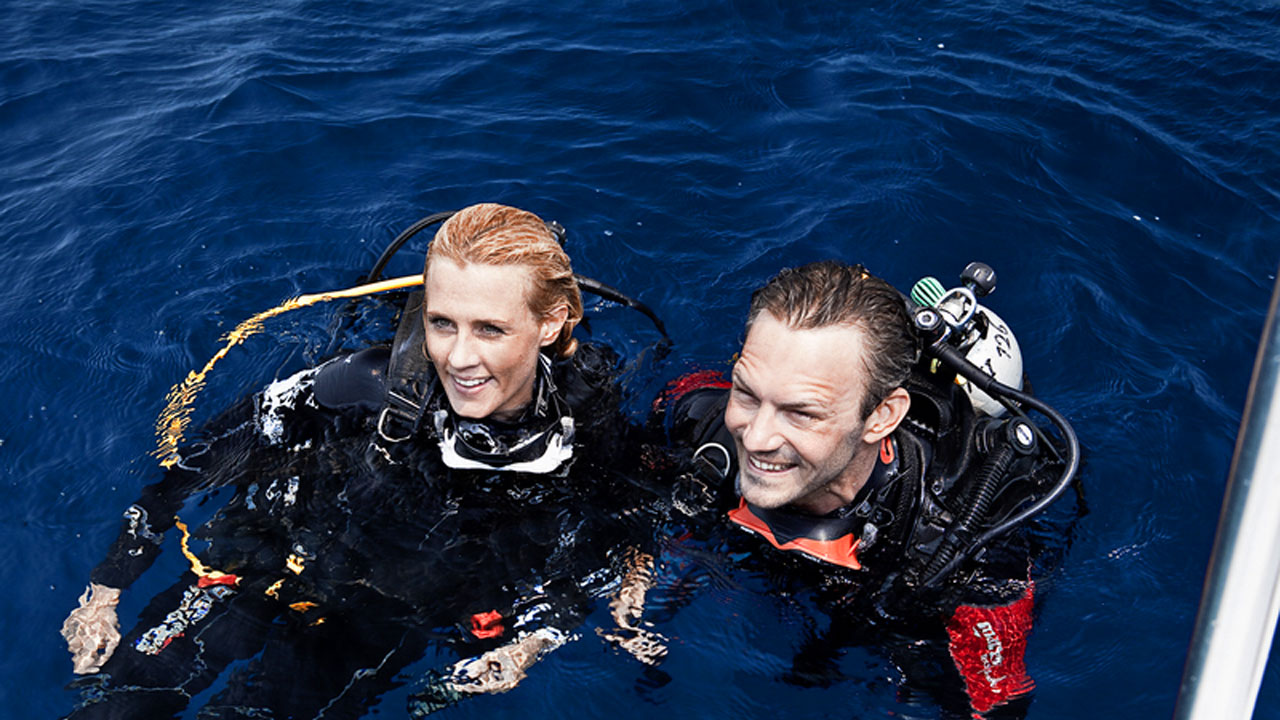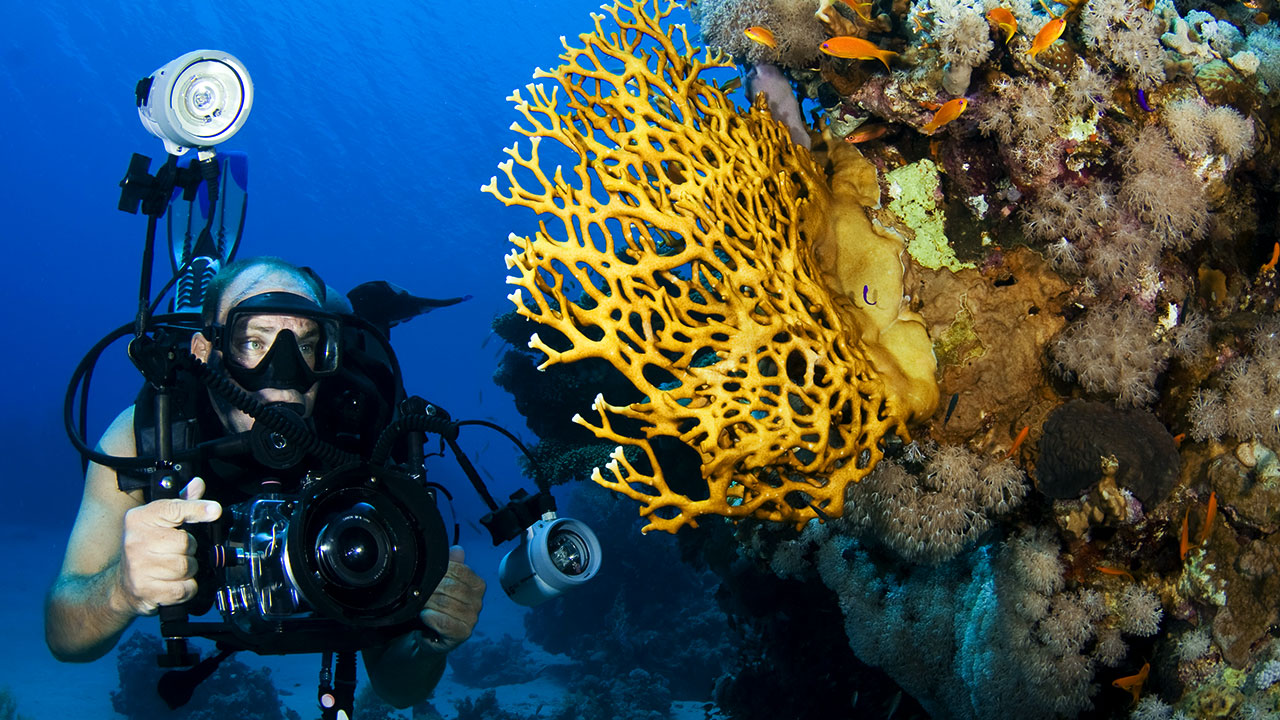Wall Diving: How to Prepare and What to Expect

Wall diving is an activity that often evokes mixed feelings and even a cautious attitude. However, this seemingly intimidating type of scuba adventure is not difficult or dangerous if you are properly prepared. In fact, many divers fall in love with wall diving once they experience that thrill of looking down at the deep blue void combined with an overwhelming beauty of vibrant marine fife.
So what is considered to be a wall? In the context of diving, the wall is a near-vertical underwater surface, such as a rock facade or a massive outgrowth of hard coral. The distinguishing characteristic of most underwater walls is that their base is beyond recreational diving depth. Aside from that each wall has its own peculiar features and unique residents.
The criteria that set walls apart are the depth at which the wall begins, its distance from shore and the contour of its facade. All of this varies from country to country and site to site. Some walls are almost perfectly vertical, plunging straight down into the depths. Others form a steep slope or descend in terraces. The majority of walls are also filled with intricate passageways, tunnels, and crevices. Thanks to such a complex structure, the wall becomes a home for many forms of marine life. Sponges and coral carpet the facade of the wall, while various cracks and holes provide hiding places for tunicates, mollusks, crinoids, crabs and other creatures of different sizes and shapes. What’s more, it is not uncommon to encounter the larger fishes, such a s jacks, rays and even sharks cruising by.
Experienced wall diving enthusiasts claim that no two walls are the same, each of them holds a new adventure and a new challenge.
Ways to Explore
There are essentially two ways to try wall diving - go on a guided group dive or explore the wall independently with your buddy. If you are new to wall diving, a guided tour may be a better option, as it is easier and relatively worry-free. At many destinations dive guides will be placed in front and behind the group. This is especially useful if you have to swim through twisting passageways or chimneys during the course of the dive.
In case you decide to explore the wall on your own, remember, in addition to maintaining awareness of your depth, air supply and bottom time you will also need to take care of dive planning and navigation. It is important that you learn the specific features of the wall you will dive, such as at what depth the wall begins, will you have to pass any overhead environments during the dive, are there any currents along the wall. As always, try to descend to your maximum planned depth first and gradually ascend on your way back exploring the wall.
Navigation is actually the simple part in wall diving. You only have two directions to choose from and the wall will be either on your left or right side depending on direction.
Regarding locations for wall diving, most people prefer clear warm tropical waters with varied and colorful marine life. For instance, some of the best dive sites for wall diving are located in Cozumel, Cayman Islands, Palau, Bahamas, and Fiji. However, sheer vertical facades exist at inland dive sites throughout the US and North America as well. Some great spots for wall diving include Puget Sound in Washington, Monterey Bay and Catalina Island in California, etc.
Special Skills
While wall diving, in general, does not require any special training, good diving fitness and mastery of basic scuba skills are a must. What’s more, some walls may require dives to a depth greater than 60 feet (18 m), which means that you need to complete a deep diver specialty course in order to enjoy the experience. Although the rules of scuba don’t suddenly change once you go beyond 60 feet, it is important to diligently monitor your air supply, depth and bottom time. Remember, with increasing depth you consume air and accumulate nitrogen faster, while the no-decompression bottom time becomes shorter. The relevant scuba course will cover the abovementioned factors and help you develop the necessary skills and habits.
Because the majority of walls will stretch far beyond your planned maximum depth, giving you no bottom for reference, buoyancy control is a critical skill for this type of diving. Remember, you will get more negatively buoyant as you descend. Add small portions of air into your BC to slow the rate of descent and establish neutral buoyancy upon reaching the desired diving depth. When ascending vent the expanding air from your BCD early and often. Don’t forget to make safety stops.
Another important skill for wall diving is the buddy system. Agree on your communication plan, maximum depth and bottom time before entering the water. Make sure the planned depth is comfortable for both you and your buddy to avoid the situation when one diver maintains a considerably shallower depth than the other. Try to stay within a few kick strokes from each other.
Finally, learn if there are any currents along the wall you are planning to dive. Some walls are explored as drift dives when you float with the current and the boat simply follows you to your exit point. In case there is a mild current, but you are diving from an anchored boat, start by swimming against the current, and reverse the direction on your way back to the boat.
Beware of strong upward or downward flowing currents - upwellings and downwellings. These pose the danger of pulling you deeper than desired or pushing you upward in an out-of-control, rapid ascent. In case you get caught in an upwelling current, vent air from your BC to make yourself negatively buoyant and try swimming diagonally out of the flow. To escape a downwelling, immediately inflate your BC to become more buoyant and move to the nearest wall. The upside is that upwellings and downwellings are generally localized and thus can be easily avoided if you know where they occur.
As for the equipment, in addition to your standard gear set, it is recommended that you carry a dive light, at least one safety signaling device, and alternate air supply. The light will be useful for exploring the cracks and crevices inside the wall, and a Spare Air device or pony bottle will decrease your dependence on your buddy or other divers in an out-of-air emergency.
To sum up, wall diving does include a number of specialized skills, namely deep, boat and drift diving. However, you don't have to complete all these specialties before going on your first wall dive. Simply choose the location that suits your existing skills, polish the basic diving techniques, work on your buoyancy control and you will be ready to go.




